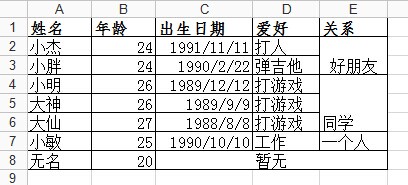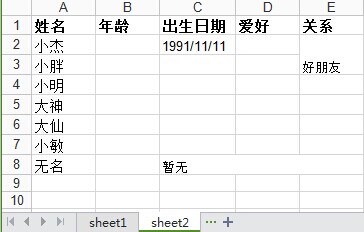python读excel——xlrd
这个过程有几个比较麻烦的问题,比如读取日期、读合并单元格内容。下面先看看基本的操作:
首先读一个excel文件,有两个sheet,测试用第二个sheet,sheet2内容如下:

python 对 excel基本的操作如下:
|
1
2
3
4
5
6
7
8
9
10
11
12
13
14
15
16
17
18
19
20
21
22
23
24
25
26
27
28
29
30
31
32
33
34
35
|
# -*- coding: utf-8 -*- import xlrd import xlwt from datetime import date,datetime def read_excel(): # 打开文件 workbook = xlrd.open_workbook(r'F:demo.xlsx') # 获取所有sheet print workbook.sheet_names() # [u'sheet1', u'sheet2'] sheet2_name = workbook.sheet_names()[1] # 根据sheet索引或者名称获取sheet内容 sheet2 = workbook.sheet_by_index(1) # sheet索引从0开始 sheet2 = workbook.sheet_by_name('sheet2') # sheet的名称,行数,列数 print sheet2.name,sheet2.nrows,sheet2.ncols # 获取整行和整列的值(数组) rows = sheet2.row_values(3) # 获取第四行内容 cols = sheet2.col_values(2) # 获取第三列内容 print rows print cols # 获取单元格内容 print sheet2.cell(1,0).value.encode('utf-8') print sheet2.cell_value(1,0).encode('utf-8') print sheet2.row(1)[0].value.encode('utf-8') # 获取单元格内容的数据类型 print sheet2.cell(1,0).ctype if __name__ == '__main__': read_excel() |
运行结果如下:
那么问题来了,上面的运行结果中红框框中的字段明明是出生日期,可显示的确实浮点数。好的,来解决第一个问题:
1、python读取excel中单元格内容为日期的方式
python读取excel中单元格的内容返回的有5种类型,即上面例子中的ctype:
|
1
|
ctype : 0 empty,1 string, 2 number, 3 date, 4 boolean, 5 error |
即date的ctype=3,这时需要使用xlrd的xldate_as_tuple来处理为date格式,先判断表格的ctype=3时xldate才能开始操作。现在命令行看下:
|
1
2
3
4
5
6
7
8
9
10
11
12
13
14
15
|
>>> sheet2.cell(2,2).ctype #1990/2/22 >>> sheet2.cell(2,1).ctype #24 >>> sheet2.cell(2,0).ctype #小胖 >>> sheet2.cell(2,4).ctype #空值(这里是合并单元格的原因) >>> sheet2.cell(2,2).value #1990/2/22 33656.0>>> xlrd.xldate_as_tuple(sheet2.cell_value(2,2),workbook.datemode) (1992, 2, 22, 0, 0, 0) >>> date_value = xlrd.xldate_as_tuple(sheet2.cell_value(2,2),workbook.datemode) >>> date_value (1992, 2, 22, 0, 0, 0) >>> date(*date_value[:3]) datetime.date(1992, 2, 22) >>> date(*date_value[:3]).strftime('%Y/%m/%d') '1992/02/22' |
即可以做下简单处理,判断ctype是否等于3,如果等于3,则用时间格式处理:
|
1
2
3
|
if (sheet.cell(row,col).ctype == 3): date_value = xlrd.xldate_as_tuple(sheet.cell_value(rows,3),book.datemode) date_tmp = date(*date_value[:3]).strftime('%Y/%m/%d') |
那么问题又来了,上面 sheet2.cell(2,4).ctype 返回的值是0,说明这个单元格的值是空值,明明是合并的单元格内容"好朋友",这个是我觉得这个包功能不完善的地方,如果是合并的单元格那么应该合并的单元格的内容一样,但是它只是合并的第一个单元格的有值,其它的为空。
|
1
2
3
4
5
6
7
8
9
10
11
12
13
14
15
16
17
18
19
20
21
22
|
>>> sheet2.col_values(4) [u'u5173u7cfb', u'u597du670bu53cb', '', u'u540cu5b66', '', '', u'u4e00u4e2au4eba', ''] >>> for i in range(sheet2.nrows): print sheet2.col_values(4)[i] 关系 好朋友 同学 一个人 >>> sheet2.row_values(7) [u'u65e0u540d', 20.0, u'u6682u65e0', '', ''] >>> for i in range(sheet2.ncols): print sheet2.row_values(7)[i] 无名 20.0暂无 >>> |
2、读取合并单元格的内容
这个是真没技巧,只能获取合并单元格的第一个cell的行列索引,才能读到值,读错了就是空值。
即合并行单元格读取行的第一个索引,合并列单元格读取列的第一个索引,如上述,读取行合并单元格"好朋友"和读取列合并单元格"暂无"只能如下方式:
|
1
2
3
4
5
6
7
|
>>> print sheet2.col_values(4)[1] 好朋友 >>> print sheet2.row_values(7)[2] 暂无 >>> sheet2.merged_cells # 明明有合并的单元格,为何这里是空 [] |
疑问又来了,合并单元格可能出现空值,但是表格本身的普通单元格也可能是空值,要怎么获取单元格所谓的"第一个行或列的索引"呢?
这就要先知道哪些是单元格是被合并的!
3、获取合并的单元格
读取文件的时候需要将formatting_info参数设置为True,默认是False,所以上面获取合并的单元格数组为空,
|
1
2
3
4
|
>>> workbook = xlrd.open_workbook(r'F:demo.xlsx',formatting_info=True) >>> sheet2 = workbook.sheet_by_name('sheet2') >>> sheet2.merged_cells [(7, 8, 2, 5), (1, 3, 4, 5), (3, 6, 4, 5)] |
merged_cells返回的这四个参数的含义是:(row,row_range,col,col_range),其中[row,row_range)包括row,不包括row_range,col也是一样,即(1, 3, 4, 5)的含义是:第1到2行(不包括3)合并,(7, 8, 2, 5)的含义是:第2到4列合并。
利用这个,可以分别获取合并的三个单元格的内容:
|
1
2
3
4
5
6
|
>>> print sheet2.cell_value(1,4) #(1, 3, 4, 5) 好朋友 >>> print sheet2.cell_value(3,4) #(3, 6, 4, 5) 同学 >>> print sheet2.cell_value(7,2) #(7, 8, 2, 5) 暂无 |
发现规律了没?是的,获取merge_cells返回的row和col低位的索引即可! 于是可以这样一劳永逸:
|
1
2
3
4
5
6
7
8
9
10
11
12
13
|
>>> merge = [] >>> for (rlow,rhigh,clow,chigh) in sheet2.merged_cells: merge.append([rlow,clow]) >>> merge [[7, 2], [1, 4], [3, 4]] >>> for index in merge: print sheet2.cell_value(index[0],index[1]) 暂无 好朋友 同学 >>> |
python写excel——xlwt
写excel的难点可能不在构造一个workbook的本身,而是填充的数据,不过这不在范围内。在写excel的操作中也有棘手的问题,比如写入合并的单元格就是比较麻烦的,另外写入还有不同的样式。这些要看源码才能研究的透。
我"构思"了如下面的sheet1,即要用xlwt实现的东西:

基本上看起来还算复杂,而且看起来"很正规",完全是个人杜撰。
代码如下:
|
1
2
3
4
5
6
7
8
9
10
11
12
13
14
15
16
17
18
19
20
21
22
23
24
25
26
27
28
29
30
31
32
33
34
35
36
37
38
39
40
41
42
43
44
45
46
47
48
49
50
51
52
53
54
55
56
57
58
59
60
61
62
63
64
65
|
''' 设置单元格样式 ''' def set_style(name,height,bold=False): style = xlwt.XFStyle() # 初始化样式 font = xlwt.Font() # 为样式创建字体 font.name = name # 'Times New Roman' font.bold = bold font.color_index = 4 font.height = height # borders= xlwt.Borders() # borders.left= 6 # borders.right= 6 # borders.top= 6 # borders.bottom= 6 style.font = font # style.borders = borders return style #写excel def write_excel(): f = xlwt.Workbook() #创建工作簿 ''' 创建第一个sheet: sheet1 ''' sheet1 = f.add_sheet(u'sheet1',cell_overwrite_ok=True) #创建sheet row0 = [u'业务',u'状态',u'北京',u'上海',u'广州',u'深圳',u'状态小计',u'合计'] column0 = [u'机票',u'船票',u'火车票',u'汽车票',u'其它'] status = [u'预订',u'出票',u'退票',u'业务小计'] #生成第一行 for i in range(0,len(row0)): sheet1.write(0,i,row0[i],set_style('Times New Roman',220,True)) #生成第一列和最后一列(合并4行) i, j = 1, 0 while i < 4*len(column0) and j < len(column0): sheet1.write_merge(i,i+3,0,0,column0[j],set_style('Arial',220,True)) #第一列 sheet1.write_merge(i,i+3,7,7) #最后一列"合计" i += 4 j += 1 sheet1.write_merge(21,21,0,1,u'合计',set_style('Times New Roman',220,True)) #生成第二列 i = 0 while i < 4*len(column0): for j in range(0,len(status)): sheet1.write(j+i+1,1,status[j]) i += 4 f.save('demo1.xlsx') #保存文件 if __name__ == '__main__': #generate_workbook() #read_excel() write_excel() |
需要稍作解释的就是write_merge方法:
write_merge(x, x + m, y, w + n, string,
sytle)
x表示行,y表示列,m表示跨行个数,n表示跨列个数,string表示要写入的单元格内容,style表示单元格样式。其中,x,y,w,h,都是以0开始计算的。
这个和xlrd中的读合并单元格的不太一样。
如上述:sheet1.write_merge(21,21,0,1,u'合计',set_style('Times New Roman',220,True))
即在22行合并第1,2列,合并后的单元格内容为"合计",并设置了style。
如果需要创建多个sheet,则只要f.add_sheet即可。
如在上述write_excel函数里f.save('demo1.xlsx') 这句之前再创建一个sheet2,效果如下:

代码也是真真的easy的了:
|
1
2
3
4
5
6
7
8
9
10
11
12
13
14
15
16
17
18
19
20
21
|
''' 创建第二个sheet: sheet2 ''' sheet2 = f.add_sheet(u'sheet2',cell_overwrite_ok=True) #创建sheet2 row0 = [u'姓名',u'年龄',u'出生日期',u'爱好',u'关系'] column0 = [u'小杰',u'小胖',u'小明',u'大神',u'大仙',u'小敏',u'无名'] #生成第一行 for i in range(0,len(row0)): sheet2.write(0,i,row0[i],set_style('Times New Roman',220,True)) #生成第一列 for i in range(0,len(column0)): sheet2.write(i+1,0,column0[i],set_style('Times New Roman',220)) sheet2.write(1,2,'1991/11/11') sheet2.write_merge(7,7,2,4,u'暂无') #合并列单元格 sheet2.write_merge(1,2,4,4,u'好朋友') #合并行单元格 f.save('demo1.xlsx') #保存文件 |
